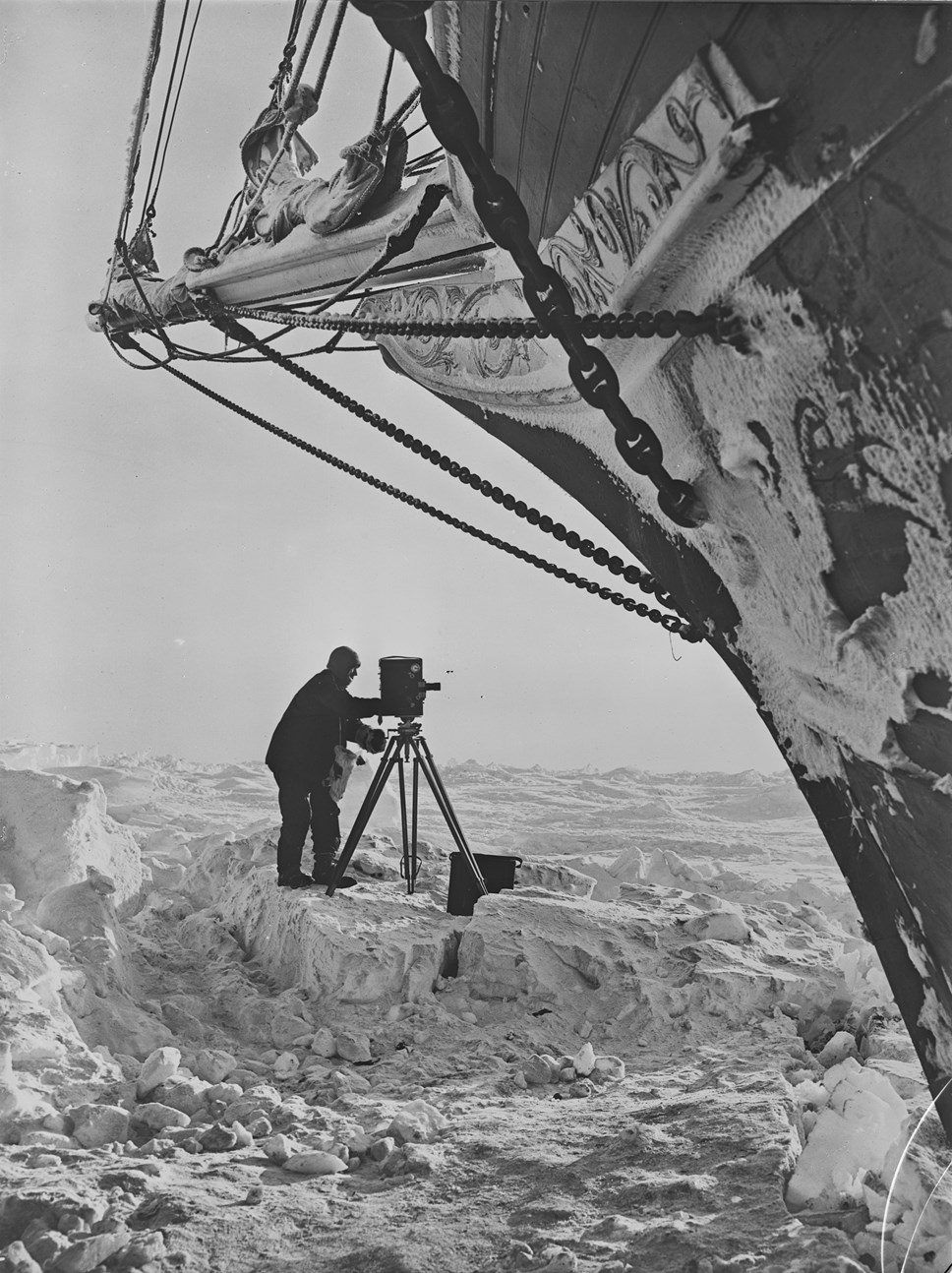
HAUNTING PHOTOGRAPHS REVEAL AMAZING SURVIVAL STORY
Exhibition shows previously unseen detail in images saved from the ice
One of the greatest survival stories of all time is being told at the National Library of Scotland this summer, taking visitors on an epic journey to Antarctica with Sir Ernest Shackleton and the crew of the Endurance.
Newly digitised images, processed from fragile 100 year-old glass plate and celluloid negatives, lie at the heart of this major exhibition, revealing previously unseen detail of the crew’s struggle to survive.
The Endurance expedition marked one of the greatest ever polar journeys. The aim was to cross the Antarctic continent from coast to coast but the Endurance had to be abandoned after it was crushed by ice, forcing the men to live on ice floes for months in freezing, hostile conditions before attempting a rescue. All the men were eventually saved.
The exhibition, Enduring Eye, honours the achievements of the men of the Imperial Trans-Antarctic Expedition (1914–17) on its centenary. It has been prepared by the Royal Geographical Society (with the Institute of British Geographers), augmented by material from the Library’s own polar collection. In addition to the haunting photographs, visitors have the rare chance to see personal items carried through every stage of the polar journey.
One of these is a tartan blanket given to expedition’s Scottish geologist James Wordie by his sister. After the ship sank, it was adapted into a jacket to help give some protection against the fierce polar winter. Also on show is a paperknife, crafted from a wooden tent peg, and given to Wordie by his fellow Scot Henry McNish, the ship’s carpenter whose skills were essential in getting the men to safety.
The story is told in more than 90 photographs, taken from the negatives that were saved by the expedition’s official photographer Frank Hurley. It is remarkable that they survived at all after being submerged in “mushy” ice inside the Endurance for a fortnight after the ship sank. From the 550 plates that were recovered, Hurley could carry only 150 and the others had to be abandoned. They provide an incredible lasting record of the men of Endurance and their fight to survive.
The negatives have been stored at the Royal Geographical Society (with IBG) for more than 80 years and have now been digitised for the first time. They unlock the remarkable detail captured originally by Hurley, including interior images of the Endurance and life on the pack ice of the Weddell Sea.
As one of the first truly modern documentary photographers and film-makers, Australian born Hurley hoped to have his images seen as large as possible. A century later, the exhibition fulfils that wish with large dimension prints, some over two metres in width and height, providing viewers with a sense of awe and wonder.
Visitors to the exhibition will also be able to see an original copy of the expedition prospectus which set out the plans and carried testimonials from explorers and scientists including Roald Amundsen, who led the first successful expedition to the South Pole in 1911 and Admiral Robert Peary who conquered the North Pole in 1909.
In the prospectus, Shackleton appeals for funds to make the exhibition a success, stressing its importance. “From the sentimental point of view, it is the last great Polar journey that can be made. It will be a greater journey than the journey to the Pole and back, and I feel it is up to the British nation to accomplish this, for we have been beaten at the conquest of the North Pole and beaten at the conquest of the South Pole.”
Other highlights include contemporary newspaper cuttings which are part of the Wordie papers held by the Library and correspondence between Shackleton and Lord Rosebery.
Paula Williams, curator of maps, mountaineering and polar collections at the National Library said: “Polar expeditions caught the public imagination 100 years ago and continue to fascinate to this day. The stunning photographs in this exhibition tell an amazing story of human daring and endurance in the most hostile of circumstances.”
Alasdair MacLeod, Head of Enterprise and Resources at Royal Geographical Society (with IBG), said: "We are delighted to be working with the National Library to share this extraordinary story with the widest audience possible. Through Hurley’s incredible images and the local links to the expedition, we hope to inspire people to learn more about the world’s last great wilderness and the work of today’s scientists to further understanding of it.”
The exhibition has been researched, written and curated by Meredith Hooper, the Antarctic historian, writer and broadcaster, from original source material in the UK, Australia and New Zealand, whilst also drawing also on information provided by descendants of some of the 28 men on the expedition.
Enduring Eye runs from June 16-November 12 at George IV Bridge in Edinburgh. Entry is free.
The exhibition is touring various venues around the UK and this is its only Scottish venue. During the tour, Shackleton's Endurance: Discovering Our Shared Antarctic Heritage, a project enabled by the Heritage Lottery Fund, is exploring local links and visitor or family stories connected to the Endurance expedition.
About the National Library of Scotland
The National Library of Scotland is a major European research library and one of the world’s leading centres for the study of Scotland and the Scots - an information treasure trove for Scotland’s knowledge, history and culture. The Library’s collections are of world-class importance. Key areas include digital material, rare books, manuscripts, maps, music, moving images, official publications, business information, science and technology, and modern and foreign collections. The Library holds more than 26 million physical items dating back over 1000 years in addition to a growing library of e-books, e-journals and other digital material. The collection includes over four million books, eight million manuscripts, two million maps and over 45,000 films and videos. Every week the Library collects around 4,000 new items. Most of these are received free of charge in terms of Legal Deposit legislation. Further information is available at www.nls.uk
About the Royal Geographical Society (with IBG)
The Royal Geographical Society (with the Institute of British Geographers) is the learned society and professional body for geography. Formed in 1830 for 'the advancement of geographical science', today we deliver this objective through developing, supporting and promoting geographical research, expeditions and fieldwork, education, public engagement, and geography input to policy. We aim to foster an understanding and informed enjoyment of our world. We hold the world's largest private geographical collection and provide public access to it. We have a thriving Fellowship and membership and offer the professional accreditation 'Chartered Geographer’ www.rgs.org
